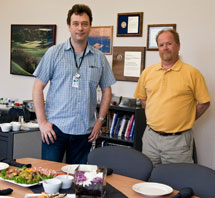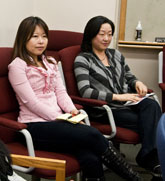
Handy Links
SLAC News Center
SLAC Today
- Subscribe
- Archives: Feb 2006-May 20, 2011
- Archives: May 23, 2011 and later
- Submit Feedback or Story Ideas
- About SLAC Today
SLAC News
Lab News
- Interactions
- Lightsources.org
- ILC NewsLine
- Int'l Science Grid This Week
- Fermilab Today
- Berkeley Lab News
- @brookhaven TODAY
- DOE Pulse
- CERN Courier
- DESY inForm
- US / LHC
SLAC Links
- Emergency
- Safety
- Policy Repository
- Site Entry Form

- Site Maps
- M & O Review
- Computing Status & Calendar
- SLAC Colloquium
- SLACspeak
- SLACspace
- SLAC Logo
- Café Menu
- Flea Market
- Web E-mail
- Marguerite Shuttle
- Discount Commuter Passes
-
Award Reporting Form
- SPIRES
- SciDoc
- Activity Groups
- Library
Stanford
Around the Bay
SLAC Staff Members Home Safe from Japan
Thanks to the preparedness of their Japanese hosts and their own cool heads, two physicists from the Accelerator Research Division have returned home safe and sound from KEK after being caught up in the events of the earthquake last Friday in Japan. They bring with them valuable information for future SLAC travelers and an appreciation for the efforts of their SLAC colleagues to keep the lines of communication open.
At first neither Glen White nor Mark Woodley, hard at work in the control room for the Accelerator Test Facility 2 in Tsukuba, Japan, realized anything was wrong. "If you're in Japan for any time at all you'll feel an earthquake," White said. "And there was a very slow build-up for this one—one truck rolled past and shook the building and another rolled past and shook the building, but then—it didn't stop. Then the power went out and stuff started flying off the shelves." The two took shelter under tables.
"We thought the earthquake couldn't possibly go on and on and on and on like it did," said Woodley, but the shaking continued for a full two minutes. They finally evacuated the building even as the ground continued to heave.
The ordeal did not end there. While the two waited to be checked off by members of KEK's Emergency Response Team, an aftershock hit, registering 6.7 on the Richter Scale and located much closer to KEK. According to White, the initial temblor was certainly memorable but the close confines of the control room masked its power. Once he was outside, the effect was very different.
"Seeing the ground physically moving—it doesn't seem right," he said.
The two drove back to the SLAC guest house through dense but orderly traffic. With no power and no phone, they were unable to learn the true extent of the damage. White managed to use Skype to contact his wife, who hadn't yet learned of the earthquake. Then he contacted Tonee Smith, a colleague in ARD, who passed on word to Woodley's wife that he was safe.
Enter Naomi Nagahashi. On normal days, her duties include coordinating Japanese funding from KEK, supporting SLAC travelers to Japan and KEK travelers to the U.S., and managing the use of the SLAC guest house near KEK. Nagahashi was next to learn of the disaster and she immediately went to work.
"I monitor my e-mail and Japanese websites at night in order to reply to messages from Japan during their working hours, so I learned of the earthquake and tsunami during the night," she explained. "I immediately tried to contact Glen and Mark by e-mail or phone, but had no success." Even while waiting for news of her own family in Tokyo she continued to marshal resources for the travelers—including locating the closest supply of fresh water—often working through colleagues at KEK to find information. She notified the men's supervisors and SLAC management. She maintained her new role as a one-woman communications hub during the entire time the men were in Japan, even forwarding them the names of friends and family in Tokyo and Narita in case they were not able to return to the U.S.
Meanwhile, on Friday morning SLAC-time, Melissa Lim of the travel group saw videos of the devastation wrought by the tsunami. "They looked horrible," she said. "I thought, 'Oh, my gosh, I have to find out who's there."
In short order she did just that and fired off e-mails to White, Woodley and SLAC managers with vital contacts and information for travelers in trouble—information that can now be found on the SLAC emergency website.
For the rest of the weekend the two men followed a simple strategy. "Our plan was to sit tight and wait until we could get more information about what to do, and go from there," White said. In the meantime they marveled at how calm and organized the people around them were. "There was no looting, no panic."
"The Japanese people are very strong," Woodley added.
The two men were finally able to catch a flight out, landing in SFO on Tuesday morning.
"The communication was key," said Woodley. "If we hadn't been able to communicate it would have been much worse for you here and our families. Not for us—we would have gotten on a plane and gotten home. But you wouldn't have known what was going on. "
Lance Lougée, SLAC's assistant fire marshal and emergency management coordinator, couldn't agree more. Working with SLAC Travel, he will soon formalize an emergency procedure for SLAC travelers in which communication is front and center. "We had all the pieces and parts [of the procedure]," Lougée said, "but now we want to make it official." Tactics included the emergency e-mail sent by Lim, and updating the SLAC emergency website to include situation-specific information. One new piece—identifying SLAC employees with local know-how for the countries most visited by lab staff—was prompted by Nagahashi.
"Naomi did an incredible job," Lougée said.
"I wanted to help my colleagues," she explained. "They speak very little Japanese, and I could not imagine how scary it would be to experience this horrible situation in foreign country."
—Lori Ann White
SLAC Today, March 17, 2011

